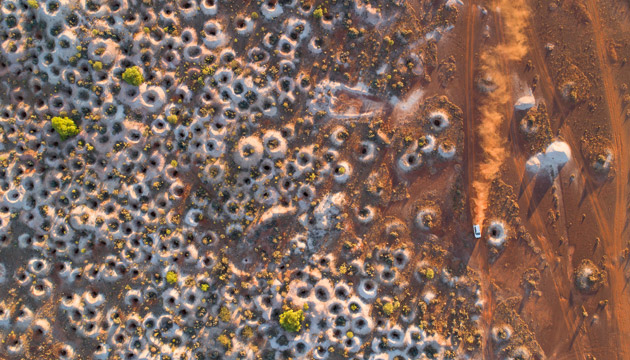Nick Rains’s first trip in a helicopter was in 1985, when he was photographing the America’s Cup races off Fremantle.
Photos Nick Rains
“That was a real blast,” he says. “But since then I’ve been shooting from just about anything that flies. The craziest thing was this contraption in the Maldives – a guy had stuck an inflatable dinghy on the bottom of a microlight to make some sort of amphibious machine.”
Another aerial escapade resulted in one of his favourite images (opposite), taken from a mustering chopper on Carlton Hill station in the Kimberley. “Photographers get attached to particular images because of the experience getting them, and that is one of mine,” he says. “We were very much part of the mustering process – we were up high and then we were down low knocking the cattle with the skids of the helicopter, and then two feet off the ground and could pretty much step out of the chopper.”
Brisbane-based but often travelling throughout Australia, Nick has won multiple awards and his photographs have been published around the world. His last feature for OUTBACK was on an Outback Communities Authority project that’s helping remote communities in South Australia (issue 95) and he is currently shooting a year-long project on rural festivals, from Barunga Festival in the Top End to the Huon Valley Mid-Winter Fest. Although many of his subjects are on the ground, he has compiled many of his stunning aerial images over 30 years into a book called Aerial Australia, published by Hardy Grant, and loves the different perspective you get shooting from the air.
“It’s often patterns, really,” he says. “There’s a fashion at the moment of taking a lot of outback pictures of dry creeks and interesting erosion patterns, pumping up the colours and shooting it very flat – straight down – so everything appears very two-dimensional and has no perspective. Although I sometimes shoot like that, such as in the photo of the White Cliffs opal mine workings, I prefer trying to keep things as realistic as possible, while still looking for patterns. So I prefer shooting across the landscape and using low-angled light to bring out features.”
Nick says that modern camera technology allows much faster shutter speeds in low light, and the resolution is much better, aiding shooting at the beginning and end of the day. And he says that although drones have made some aerial photography cheaper and more accessible to many people, there is nothing like having a photographer actually in the air.
“Drones generally only have a 400-foot limit, which really isn’t that high,” he says. “I love shooting from much higher up.”
This story excerpt is from Issue #123
Outback Magazine: February/March 2019










